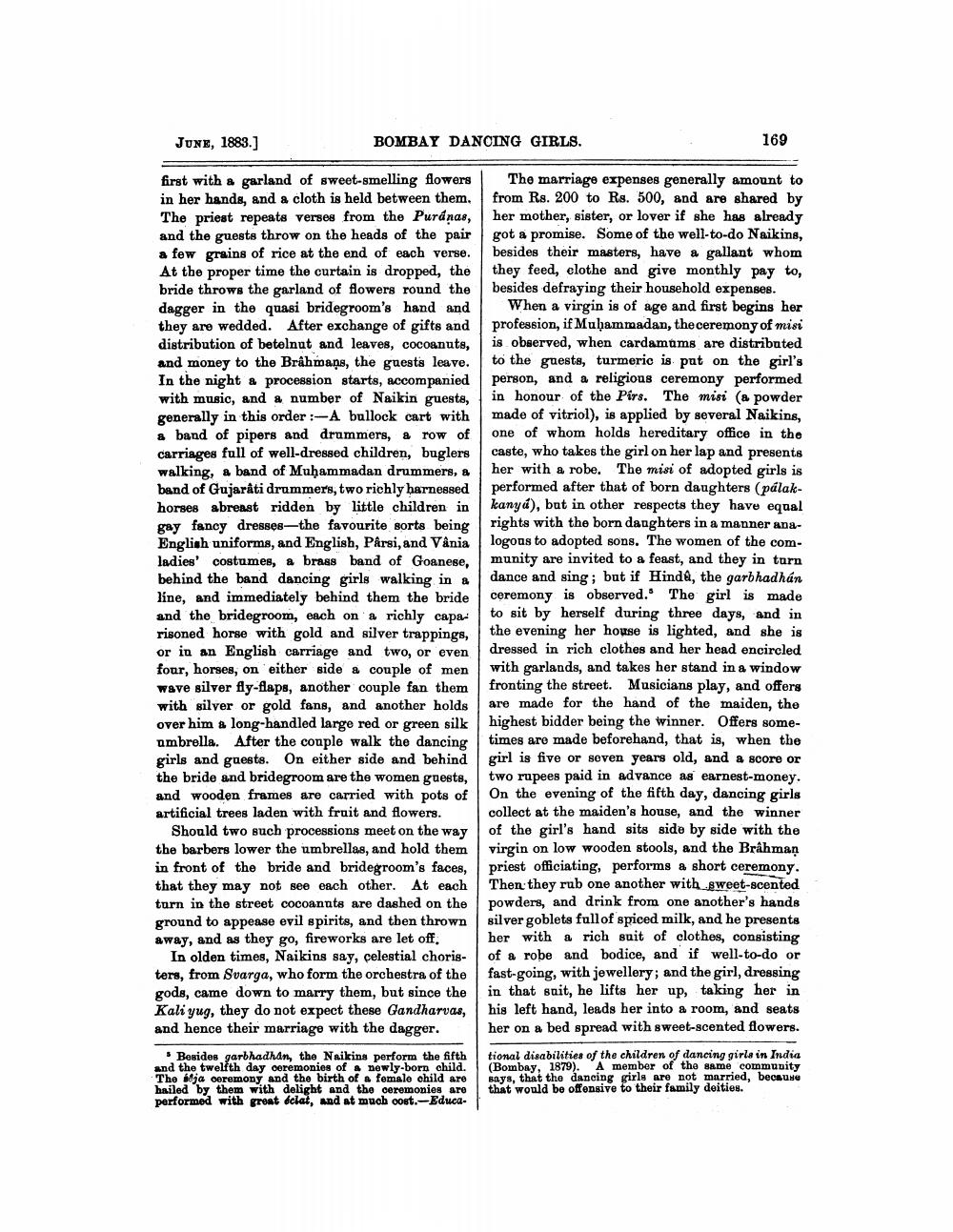________________
JUNE, 1883.]
BOMBAY DANCING GIRLS.
169
first with a garland of sweet-smelling flowers in her hands, and a cloth is held between them. The priest repeats verses from the Puranas, and the guests throw on the heads of the pair
few grains of rice at the end of each verse. At the proper time the curtain is dropped, the bride throws the garland of flowers round the dagger in the quasi bridegroom's hand and they are wedded. After exchange of gifts and distribution of betelnut and leaves, cocoanuts, and money to the Brahmans, the guests leave. In the night & procession starts, accompanied with music, and a number of Naikin guests, generally in this order :-A bullock cart with a band of pipers and drummers, a row of carriages full of well-dressed children, buglers walking, a band of Muhammadan drummers, & band of Gujarati drummers, two richly harnessed horses abreast ridden by little children in gay fancy dresses--the favourite sorts being English uniforms, and English, Pârsi, and Vånia ladies' costumes, a brass band of Goanese, behind the band dancing girls walking in a líne, and immediately behind them the bride and the bridegroom, each on a richly capa. risoned horse with gold and silver trappings, or in an English carriage and two, or even four, horses, on either side a couple of men wave silver fly-flaps, another couple fan them with silver or gold fans, and another holds over him a long-handled large red or green silk umbrella. After the couple walk the dancing girls and guests. On either side and behind the bride and bridegroom are the women guests, and wooden frames are carried with pots of artificial trees laden with fruit and flowers.
Should two such processions meet on the way the barbers lower the umbrellas, and hold them in front of the bride and bridegroom's faces, that they may not see each other. At each turn in the street cocoannts are dashed on the ground to appease evil spirits, and then thrown away, and as they go, fireworks are let off.
In olden times, Naikins say, celestial choris- ters, from Svarga, who form the orchestra of the gods, came down to marry them, but since the Kali yug, they do not expect these Gandharvas, and hence their marriage with the dagger.
The marriage expenses generally amount to from Rs. 200 to Rs. 500, and are shared by her mother, sister, or lover if she has already got a promise. Some of the well-to-do Naikins, besides their masters, have a gallant whom they feed, clothe and give monthly pay to, besides defraying their household expenses.
When a virgin is of age and first begins her profession, if Muhammadan, the ceremony of misi is observed, when cardamoms are distributed to the guests, turmeric is put on the girl's person, and a religious ceremony performed in honour of the Pírs. The misi (a powder made of vitriol), is applied by several Naikins, one of whom holds hereditary office in the caste, who takes the girl on her lap and presents her with a robe. The misi of adopted girls is performed after that of born daughters (pálakkanya), but in other respects they have equal rights with the born daughters in a manner analogous to adopted sons. The women of the community are invited to a feast, and they in turn dance and sing; but if Hinda, the garbhadhán ceremony is observed. The girl is made to sit by herself during three days, and in the evening her house is lighted, and she is dressed in rich clothes and her head encircled with garlands, and takes her stand in a window fronting the street. Musicians play, and offers are made for the hand of the maiden, the highest bidder being the winner. Offers sometimes are made beforehand, that is, when the girl is five or seven years old, and a soore or two rupees paid in advance as earnest-money. On the evening of the fifth day, dancing girls collect at the maiden's house, and the winner of the girl's hand sits side by side with the virgin on low wooden stools, and the Brahman priest officiating, performs a short ceremony. Then they rub one another with sweet-scented powders, and drink from one another's hands silver goblets fullof spiced milk, and he presents her with a rich suit of clothes, consisting of a robe and bodice, and if well-to-do or fast-going, with jewellery; and the girl, dressing in that suit, he lifts her up, taking her in his left hand, leads her into a room, and seats her on a bed spread with sweet-scented flowers.
Besides garbhadhan, the Naikins perform the fifth and the twelfth day ooremonies of newly-born child. The 6dja ceremony and the birth of a female child are hailed by them with delight and the ceremonies are performed with gront éclat, and at much oost.-Educa
tional disabilities of the children of dancing girls in India (Bombay. 1879). A member of the same community says, that the dancing girls are not married, because that would be offensive to their family deities.




